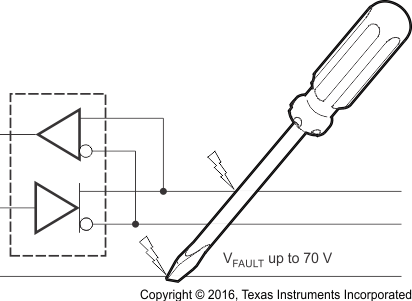JAJSV27E September 2010 – October 2024 SN65HVD1780-Q1 , SN65HVD1781-Q1 , SN65HVD1782-Q1
PRODUCTION DATA
- 1
- 1 特長
- 2 アプリケーション
- 3 概要
- 4 Pin Configuration and Functions
- 5 Specifications
- 6 Parameter Measurement Information
- 7 Detailed Description
- 8 Application and Implementation
- 9 Device and Documentation Support
- 10Revision History
- 11Mechanical, Packaging, and Orderable Information
3 概要
これらのデバイスは、電源への直接短絡、誤配線フォルト、コネクタ障害、ケーブルのクラッシュ、ツールの誤用などの過電圧フォルトに耐えられるよう設計されています。また、ESD イベントにも高い耐性を持ち、人体モデル仕様に対して高いレベルの保護を実現しています。
これらのデバイスは、差動ドライバと差動レシーバを組み合わせたもので、単一電源で動作します。'HVD1782 では、ドライバの差動出力とレシーバの差動入力が内部的に接続され、半二重 (2 線式バス) 通信に適したバス ポートを形成しています。このポートは広い同相電圧範囲を持つため、これらのデバイスは長いケーブルを使用するマルチポイント アプリケーションに適しています。これらのデバイスは、-40℃~125℃で仕様が規定されています。これらのデバイスは、業界標準の SN75176 トランシーバとピン互換であるため、ほとんどのシステムでそのまま置き換えるだけで性能を向上させることができます。
これらのデバイスは 5V 電源において ANSI TIA/EIA 485A に完全準拠しており、低消費電力のアプリケーションではドライバの出力電圧を落として、3.3V 電源で動作可能です。拡張同相電圧範囲での動作が必要なアプリケーションについては、SN65HVD1785 (SLLS872) のデータシートを参照してください。
製品情報
| 部品番号 | 信号速度 (1) | ノード数 |
|---|---|---|
| SN65HVD1780-Q1 | 最大 115kbps | 最大 320 |
| SN65HVD1781-Q1 | 最大 1Mbps | 最大 320 |
| SN65HVD1782-Q1 | 最大 10Mbps | 最大 64 |
(1) 利用可能なすべてのパッケージについては、データシートの末尾にある注文情報を参照してください。
 概略回路図
概略回路図